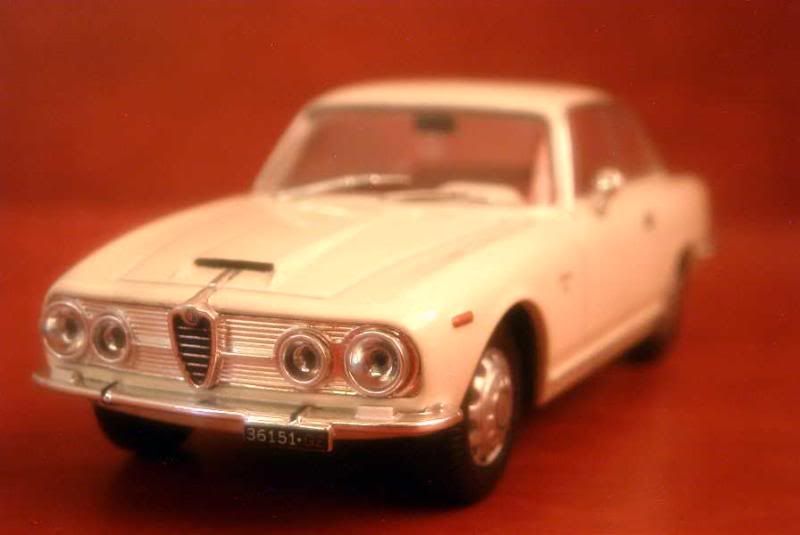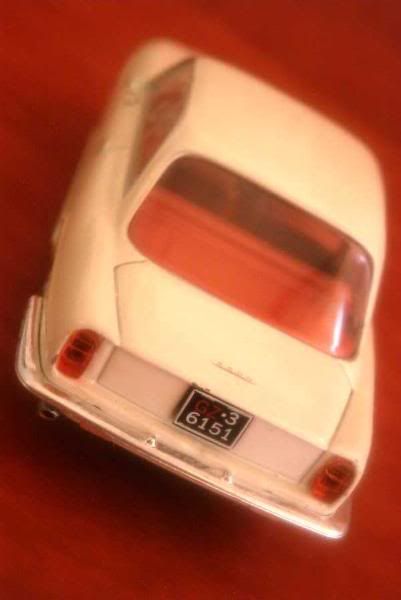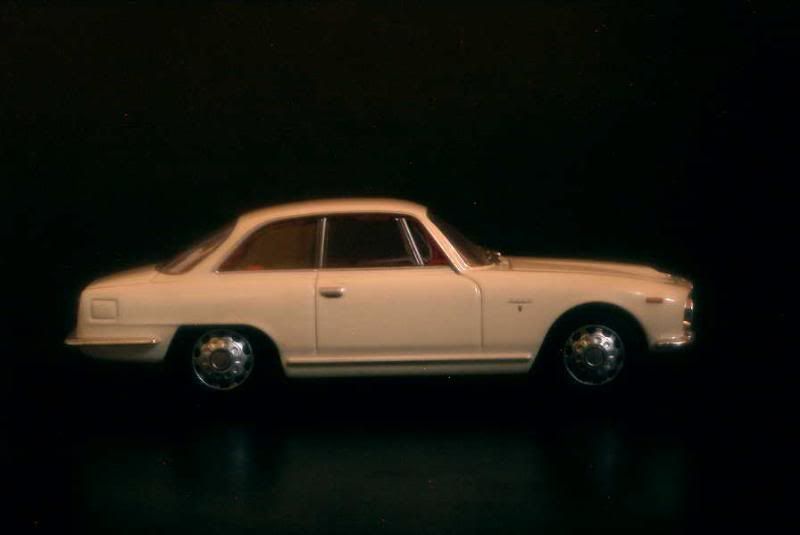A little history
As its first “mass-produced” automobile, the 1900 model, was nearing its retirement during the second half of the Fifties, Alfa Romeo decided to launch a brand new car in order to replace it: the 2000.
Introduced in 1958, the 2000 Berlina (2.0-litre four, 105 hp) was more of a family saloon than a pure Italian thoroughbred. Though not entirely succumbing to the then-fashionable American-inspired design, its finned rear quarters looked quite much the British Ford Consul/Zephyr’s one, and its wheel-mounted gear lever wasn’t exactly sporty. Nonetheless provisions were made for a performance-oriented derivative, the 2000 Spider, which design and construction were subcontracted to Touring. Using the 1900 Super Sprint’s floorpan, the Spider was a strict two-seater in which the 5-speed gearbox of the Berlina, this time commanded through a floor-mounted stick, and the engine, pushed to 115 hp thanks to a second carburettor, gave the full measure of their capacities. In addition, a splendid coupe, the Sprint, was added in 1960. It had been penned by Giorgetto Giugiaro, a promising young employee from Bertone, and was being built at this designer’s facilities.
From the very start of its production the 2000 suffered from a high price tag and controversial styling. The Berlina’s design was subject to much debate, while for the Spider, Touring had done nothing more than drawing a larger version of the 1.3-litre Giulietta Spider – it certainly looked like a Ferrari in reduction (talented indeed, Italian designers often lacked originality) but Alfa customers certainly wanted to save piles of lire by going for its smaller sister. The Sprint was seen as the only winner in Alfa’s flagship range, and sales quickly reflected this, the saloon being outsold by the coupe as soon as the latter was introduced, a rare occurrence.
At the 1962 Geneva motor show, Alfa Romeo reacted… but not necessarily the way most people expected. The car’s styling was left virtually unchanged, but its 2.0-litre four was replaced by an even more potent 2.6-litre inline six. A brilliant engine, it was entirely made of light alloy, and featured twin overhead camshafts, a traditional design of many past Alfas that won the hearts of numerous fans from the Milanese company. Fed by two carburettors, the 2600 Berlina could rely on 130 hp, while the Sprint and Spider had a bank of no less than three twin-barrel carbs, able to pull 145 hp out of the engine. The car promised good performance but, alas, no improvement regarding road-holding had been made over the 2000, and consequently the 2600 proved unable to cope with the extra power. As a result, sales remained slow. The Sprint coupe now outsold the ill-stared Berlina by 3.5 to 1, and even the exclusive Spider outpaced the saloon. Zagato gave a try at the 2600, designing an amazing “SZ” coupe, while OSI put a 2600 De Luxe saloon on the market. The latter can largely be considered a four-door version of the good-looking Sprint coupe, and the fact that a coachbuilder produced a special saloon version instead of the traditional coupes and convertibles just shows how hapless the factory Berlina was.
By then Alfa Romeo had given up all hopes in its upper-range model, preferring to concentrate all of its efforts on the successful mid-range Giulia. The 2600 lingered until 1968, without finding any real successor apart from the smaller 1750, an enlarged Giulia. Its real heir would be launched a decade later: the Alfa 6, which would prove a complete disaster. After all, Alfa Romeo is perhaps better suited for sporty cars than luxury ones.
About the model
Model: Alfa Romeo 2600 Sprint
Year: 1964
Maker: Grani & Partners
Scale: 1/43
Distributed by: unidentified Italian press series
Acquired: brand new, in February 2008, in Manila, Philippines
Not surprisingly the Sprint seems to be the 2000/2600 model that attracted the largest part of the die-cast industry's attention. This example is fine enough for a press release. The original car is beautiful, and the model reproducing it in scale, though no masterpiece, is well up to the job. My rating is 13/20.





As its first “mass-produced” automobile, the 1900 model, was nearing its retirement during the second half of the Fifties, Alfa Romeo decided to launch a brand new car in order to replace it: the 2000.
Introduced in 1958, the 2000 Berlina (2.0-litre four, 105 hp) was more of a family saloon than a pure Italian thoroughbred. Though not entirely succumbing to the then-fashionable American-inspired design, its finned rear quarters looked quite much the British Ford Consul/Zephyr’s one, and its wheel-mounted gear lever wasn’t exactly sporty. Nonetheless provisions were made for a performance-oriented derivative, the 2000 Spider, which design and construction were subcontracted to Touring. Using the 1900 Super Sprint’s floorpan, the Spider was a strict two-seater in which the 5-speed gearbox of the Berlina, this time commanded through a floor-mounted stick, and the engine, pushed to 115 hp thanks to a second carburettor, gave the full measure of their capacities. In addition, a splendid coupe, the Sprint, was added in 1960. It had been penned by Giorgetto Giugiaro, a promising young employee from Bertone, and was being built at this designer’s facilities.
From the very start of its production the 2000 suffered from a high price tag and controversial styling. The Berlina’s design was subject to much debate, while for the Spider, Touring had done nothing more than drawing a larger version of the 1.3-litre Giulietta Spider – it certainly looked like a Ferrari in reduction (talented indeed, Italian designers often lacked originality) but Alfa customers certainly wanted to save piles of lire by going for its smaller sister. The Sprint was seen as the only winner in Alfa’s flagship range, and sales quickly reflected this, the saloon being outsold by the coupe as soon as the latter was introduced, a rare occurrence.
At the 1962 Geneva motor show, Alfa Romeo reacted… but not necessarily the way most people expected. The car’s styling was left virtually unchanged, but its 2.0-litre four was replaced by an even more potent 2.6-litre inline six. A brilliant engine, it was entirely made of light alloy, and featured twin overhead camshafts, a traditional design of many past Alfas that won the hearts of numerous fans from the Milanese company. Fed by two carburettors, the 2600 Berlina could rely on 130 hp, while the Sprint and Spider had a bank of no less than three twin-barrel carbs, able to pull 145 hp out of the engine. The car promised good performance but, alas, no improvement regarding road-holding had been made over the 2000, and consequently the 2600 proved unable to cope with the extra power. As a result, sales remained slow. The Sprint coupe now outsold the ill-stared Berlina by 3.5 to 1, and even the exclusive Spider outpaced the saloon. Zagato gave a try at the 2600, designing an amazing “SZ” coupe, while OSI put a 2600 De Luxe saloon on the market. The latter can largely be considered a four-door version of the good-looking Sprint coupe, and the fact that a coachbuilder produced a special saloon version instead of the traditional coupes and convertibles just shows how hapless the factory Berlina was.
By then Alfa Romeo had given up all hopes in its upper-range model, preferring to concentrate all of its efforts on the successful mid-range Giulia. The 2600 lingered until 1968, without finding any real successor apart from the smaller 1750, an enlarged Giulia. Its real heir would be launched a decade later: the Alfa 6, which would prove a complete disaster. After all, Alfa Romeo is perhaps better suited for sporty cars than luxury ones.
About the model
Model: Alfa Romeo 2600 Sprint
Year: 1964
Maker: Grani & Partners
Scale: 1/43
Distributed by: unidentified Italian press series
Acquired: brand new, in February 2008, in Manila, Philippines
Not surprisingly the Sprint seems to be the 2000/2600 model that attracted the largest part of the die-cast industry's attention. This example is fine enough for a press release. The original car is beautiful, and the model reproducing it in scale, though no masterpiece, is well up to the job. My rating is 13/20.








No comments:
Post a Comment